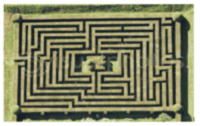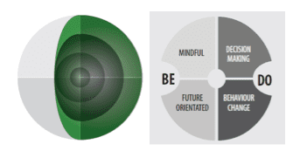Graham Williams is a South-African author and consultant and a regular guest writer for this blog. He’s one of my favorites as his articles are always a pleasure to read, well researched, and very inspiring. Graham and I share a deep wish to contribute to a better world and Graham just published another book to help organizations become more sustainable! This is crucially important and I’m happy that Graham could find the time for this interview. Check it out and read this book.
MB: Why have you written a book on sustainability?
GW: Well, the Earth is in a sorry state. It seems more fragile than ever before – ecologically, socially, economically, politically, and spiritually. Our world is fraught with tensions, discontent and dis-ease, unethical behavior. Scientists maintain that “humans are eating away their own life support systems at a rate unseen in the last 10, 000 years”. (Oliver Milman reporting in The Guardian).
Declining values look to be the order of the day. In many ways, we appear collectively to be bent on self-destruction. And perhaps we are unlike the lizard that shed its tail and is then able to regenerate it.
This is not a new challenge. In describing the Sumerian society of over 4000 years ago, Kramer notes that it “professed such ideals as justice, equity and compassion, but abounded in injustice, inequality, and oppression; materialistic and short-sighted, it unbalanced the ecology essential to its economy”. But the extent and momentum of our current, growing challenge are unprecedented.
 Dr. David Rosenstein and I co-authored the booklet as our contribution to the sustainability challenge. The Zulu proverb Ukuphosa itshe esivivaneni means to make a personal contribution to a great and worthy task. In ancient African tradition, everyone who walks past an isivivane (pile of stones, place of importance) puts their stone on the pile that is a collective, co-operative monument. It’s a way of saying ‘We’re all in this together’.
Dr. David Rosenstein and I co-authored the booklet as our contribution to the sustainability challenge. The Zulu proverb Ukuphosa itshe esivivaneni means to make a personal contribution to a great and worthy task. In ancient African tradition, everyone who walks past an isivivane (pile of stones, place of importance) puts their stone on the pile that is a collective, co-operative monument. It’s a way of saying ‘We’re all in this together’.
A child walking along a beach finds thousands of starfish washed up during a storm. So she picks up a starfish and throws it back into the ocean. Then she does the same with the next starfish. A man approaches her and says, “Little girl, look at all these stranded starfish. You can’t make a difference.” The girl bends down, picks up another starfish, and throws it as far as she can into the ocean. She looks up at the man and says, “It made a difference to that one”.
Our booklet grew out of a workshop that we presented at a major Sustainable Brands Conference in Cape Town. From there we developed, expanded and fine-tuned the concept until the book was ready to go.
MB: What were the considerations that guided you?
GW: We’ve recognized that many feel overwhelmed by the size of the people, planet, profit challenges we face, by the plethora of compliance, expert, competitive and other writings, and the numerous and sometimes confusing initiatives and debates that are taking place – many of them contradictory. Leaders are faced with loads of new jargon, regulations, measurement and reporting requirements, many emerging techniques, processes, systems and studies. Where to start? What to do?
In response, we offer a model that is simple (and hopefully profound!). One that cuts through the noise, enables them to navigate the maze and is based on a few logical, clear principles that work. It encourages all of those interested in sustainability in their organization to:
Ignore the show-offs
It is easy to find many success stories and claims. Our booklet starts with a story of a failure because that is often how the best lessons are learned.
Ignore the deceitful
A fair amount of deception and manipulation takes place. For example, there has been a stampede by organizations to claim a ‘higher purpose’. This movement is largely based on findings that staff become more fully engaged, perform better when aligned to a higher purpose, and that such firms are more attractive to customers, investors, more profitable. Some are calling it the ‘purpose economy’. There is reason to doubt the purity of motive, the authenticity of many of these firms. It’s easy to foresee that higher purpose and actual behavior disconnects are on the horizon – in the same way that we continue to see disconnects between stated values and contradictory practices.
Successful sustainability initiatives are about authentic doing and being
 Acting genuinely, with care for the environment and communities stems from the inside out: if there is no heartfelt compassion, then our doing is bound to fall short and become unsustainable at some point. All the laws, rules regulations and principles in the world do not guarantee desired behavior.
Acting genuinely, with care for the environment and communities stems from the inside out: if there is no heartfelt compassion, then our doing is bound to fall short and become unsustainable at some point. All the laws, rules regulations and principles in the world do not guarantee desired behavior.
MB: What is your model? What does the book cover?
GW: The idea is to encourage organizations to use a closed-loop model and harness the interconnected elements of mindfulness, future orientation, decision making and behavior change for better sustainability.
This has a big, positive impact on organization culture. And takes us far beyond where we now are, making a significant difference quickly. The booklet addresses:
Deeper Mindfulness
Many of us are mindless for much of the time – restless, prone to distraction, processing numerous thoughts, being busy (a default state that feeds our self-importance), impatient and always striving to achieve. Being mindful introduces calm, clarity, focus, an open and non-judgmental state.
But most importantly, new research has shown us how to leverage deeper mindfulness to build ethical maturity, discover a sense of purpose, and develop for ourselves and our people a compassion that leads to influence, positive action, balanced living, and resilience.
Future orientation
To different degrees we honor the past, are aware in the present moment and cater for the emerging future. People differ in their temporal orientations and we can plug into that in our organizations. Sustainability needs to be future-focused and we need to be future-fit. Those who grapple with the future as in alternative scenario possibilities are at the same time equipping themselves to cope better with current complexities. We are so used to deadlines, posting and reacting to quarterly results and returns, that longer term decision-making (including accounting for future generations) doesn’t happen naturally… There are sound approaches to bringing this about.
Decision making
These days with so many players in the sustainability game (businesses, NGOs, Governments, activists) we need to make collaborative decisions – and building bridges has become an even more appropriate metaphor than breaking down silos. We need to embrace paradox and ambiguity, think non-dualistically. Rumi, the Sufi poet’s ancient story of blind men discovering an elephant has lessons for us.
Each man felt a different part. To one a leg was assumed to be a pillar, the tail felt like rope, and ears like a huge fan. Yet another thought the elephant’s trunk was a branch of a tree. Each one was right in their own way but only by putting their different views together could the complete picture be seen.
 A diversity of experience, thinking style, perspectives – makes for superior decisions. Also, in order to overcome our default-setting (what Kahneman has termed System 1: fast, parallel, automatic, convenient, associative) we need to consciously employ mindful pause, allowing System 2 factors to kick in (slow, serial, controlled, effort-filled, rational and flexible). This supports virtues-based decisionmaking.
A diversity of experience, thinking style, perspectives – makes for superior decisions. Also, in order to overcome our default-setting (what Kahneman has termed System 1: fast, parallel, automatic, convenient, associative) we need to consciously employ mindful pause, allowing System 2 factors to kick in (slow, serial, controlled, effort-filled, rational and flexible). This supports virtues-based decisionmaking.
Behavior change
Proven practical tools, ancient and modern, are offered in the booklet – including the use of story (an Ubuntu process). Story properly applied is deeply relational and non-manipulative. Story listening research in the form of anecdote circles and metaphor elicitation yields rich knowledge and wisdom. Add business process re-design laboratories conducted by those who do the work. From behavioral economics, nudge theory to subtly shift behavior. Carbon conversations, pledging.
Most importantly, those employees and customer/citizens who are all-too-often left out, who feel powerless, and unable to make a meaningful contribution – are drawn in and included. We have noticed a movement within people from a focus on position, power, possessions, pleasure and perfection toward purpose, personhood, presence, planet, and people (“other orientation”).
In short, within the framework of the human dynamics model we offer clear, down-to-earth logic, new perspectives from neuroscience, psychology, behavioral economics, and other disciplines – to aid leaders and their organizations as they enter the sustainability arena.
MB: That sounds like music to my ears! What is your personal hope for the booklet?
GW: That it reaches those in the Public and Private sectors, NGOs, and activist organizations who wish to develop ethical, compassionate, forward-looking, collaborative and effective leadership. And those who are all-too-often left out.
If the booklet promotes conversations about thriving as we regenerate our environments, communities, and societies, then we’ll be well-pleased. Early feedback has been great: “This book is a decade ahead in its thinking…” (UK), “This is an incredible piece…” (USA)
The E-book can be purchased for only $ 5 at https://www.haloandnoose.com
Graham Williams is available to answer any questions from anyone at any time: az.oc.egnahcobfsctd@smailliwmaharg
Graham Williams is a certified management consultant, thought leader, business narrative practitioner and author based in Cape Town, South Africa. He can be reached at https://www.haloandnoose.com His other book is “The Virtuosa Organisation”.

This Post Has 2 Comments
Marcella & Graham; Sustainability has recently become a special interest within OD circles. I just submitted a summary tweet to support deeper mindfulness thinking (“HUMAN BEHAVIORS are MOTIVATED for Power/Affiliation/&Achievements, w&w/o evident Responsibility/Affection/&Appreciation- as the World turns.”), and noticed how it appears to correspond to Graham’s words (“We have noticed a movement within people from a focus on position, POWER, possessions, PLEASURE and PERFECTION toward purpose, personhood, presence, planet, and people- “other orientation”).” And, regarding the reasons for the new booklet (“In many ways, we appear collectively to be bent on self-destruction”). there is a relatively recent 2006, UK Open University, book entitled “Civil War and Civil Peace” that considers the Behavior factors (we are both relating to) extensively within several introductory chapters (about half of the book). Further, if one is too consider Sustainability for persons/groups/&organizations “practically”, I would suggest further study and discussion regarding the subjects of MAINTENANCE (re interpersonal relationships and servicing of things), and MORALE which is very important re attitudes, strengths, and persevering for SUSTAINING behavioral attempts and outcomes.
Ad Idem Bill!